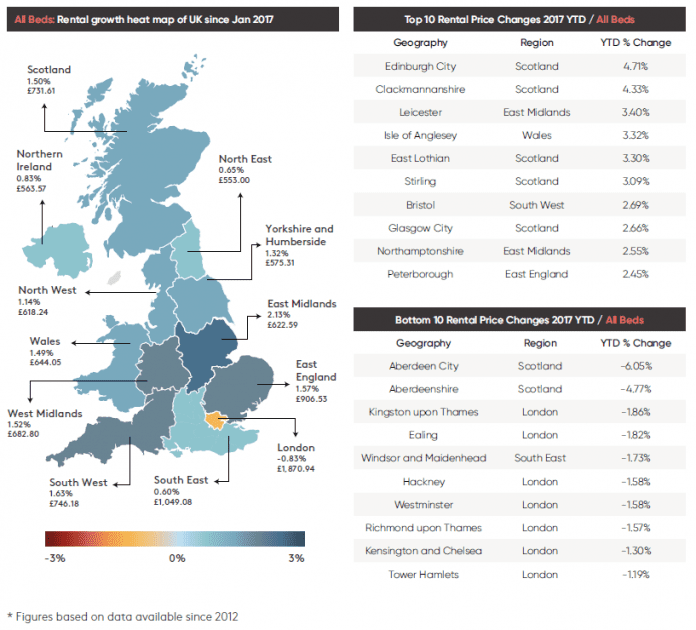UK RENTS SHRINK TOWARDS THE END OF 2017, AS A YEAR OF FALLING RENTS IN LONDON DRAGS DOWN THE UK AVERAGE
- UK rents fell by -0.01% in November 2017, the first time
rental growth has entered negative territory in at least half a decade
- Overall, UK rents grew by 0.53% in 2017 (year to date), half
the 1.22% growth by November 2016, and a quarter of the 2.3% growth by this point in 2015
- East Midlands (2.13%), South West (1.63%) and East England
(1.57%) saw the most substantial growth in 2017, while London rents shrunk by -0.83%
- Millennials renting a property outside London from age 21
will on average spend £110,800 on rent by the time they buy a house, or £1.1million if they become a lifetime renter
14TH DECEMBER 2017 – Rents across the UK began to shrink for the first time in over half a decade1 toward the end of 2017, falling by -0.01% in November, as a two-speed market emerged between London and much of the rest of the UK. The average rent paid for a UK property grew by 0.53% in
2017 (year to date), with falling rents in London (-0.83%) weighing down otherwise resilient rental growth elsewhere (1.27%).
These are the findings of the second edition of the National Rent Review from buy-to-let lender Landbay, powered by MIAC, which also reveals how much millennials can expect to spend on rent in their lifetime.
THE NATIONAL PICTURE
UK rents fell by -0.01% in November 2017- the first time rental growth has entered negative territory in at least half a decade. The average UK rent has now plateaued at a record £1,196 per month, up from £1,190 at the turn of year. Removing London from the equation puts average rents at £759, up from £750 at the turn of the year, an extra £9 per calendar month or £109 per year.
The slowdown in rental growth has not been consistent across the country. The East Midlands (2.13%), South West (1.63%) and East England
(1.57%) experienced substantial growth in 2017 and are expected to climb further as we head into 2018. The North East has also seen rents grow at a faster rate in 2017 than at any other time in the past five years (0.65%).
It is London that has seen the greatest reversal of rental growth, with November marking 18 months since rents in the capital first entered negative territory. The capital continues to be the main source of the UK’s slowdown, with rents falling in 26 of the 33 London boroughs. Rents have fallen by -0.83% year to date in 2017, compared to 1.27% growth elsewhere in the UK. Despite the narrowing gap, London rents remain, on average, 2.5 times greater than those across the rest of the UK (£1,871 vs £759).
JOHN GOODALL, CEO AND FOUNDER OF LANDBAY SAID: “Landlords have faced up to challenge after challenge over the past two years, from stricter regulation, reductions to tax relief, and a significant stamp duty tax hike when buying a buy to let property. One would expect this pressure to push up rents, but two key factors have allowed them to shoulder these rapidly rising costs: the Bank of England’s enduring Term Funding Scheme (TFS), which has injected a significant sum of cheap capital into banks, together with record low interest rates, which have also kept borrowing costs low.
“With interest rates now rising, and the TFS coming to an end in February, we expect upward rental pressure to be just around the corner.
Without a radical house building plan for purchase as well as purpose-built rental properties, rental prices are in danger of soaring over the coming decades.”
HOW MUCH MILLENNIALS SPEND ON RENT
Millennials renting an average-sized property outside of London, who begin their tenancy at age 21, will spend an average of £110,830 in household rental payments before buying their first property at the average first-time buyer age of 322. For those living in the capital, where property prices and rents are significantly higher, the average household will have spent £273,210 on rent by the time they take their first step on the property ladder.
However, as it stands today, 41% of millennials don’t expect to ever own a home of their own2, relying instead on the private rental sector to support them into old age. For this emerging generation of lifetime renters, the total amount they will spend on rent in their lifetime will be an average of £1.1million2 if living outside of London. Again, those choosing to live in the capital will spend 2.5 times this figure; a total of £2.6million.
For the fortunate millennials that are able to buy their first house at the age of 32, they will have spent 34% of their household post-tax income (£330,235) on rent (£110,830) throughout their 20s and early 30s. Meanwhile, those renting for life, and retiring at the future state pension age of 68, will have to save for 15 years of rental payments in retirement, and will therefore spend a greater proportion, some 44%, of their household disposable income (£2.4m) on rent (£1.1m) by the time they reach the average life expectancy of 82.
JOHN GOODALL, CEO AND FOUNDER OF LANDBAY SAID: “While younger people have always been overrepresented in the private rented sector, over the last decade there has been a marked increase in the proportion of younger households relying on the buy to let market. The Government is giving off strong signals that it is ready to tackle the supply shortages gripping the nation, while also improving standards, affordability and the institutional supply of rental properties in particular. This can only be good news if it becomes reality, but with so many of the issues being systemic, only time will tell if these measures will have the desired effect.”
_ _
1_ Figures based on data available since 2012_
3 Assuming 2% annual rental growth in line with the Bank of England’s inflation target
Help keep news FREE for our readers
Supporting your local community newspaper/online news outlet is crucial now more than ever. If you believe in independent journalism, then consider making a valuable contribution by making a one-time or monthly donation. We operate in rural areas where providing unbiased news can be challenging. Read More About Supporting The West Wales Chronicle

























